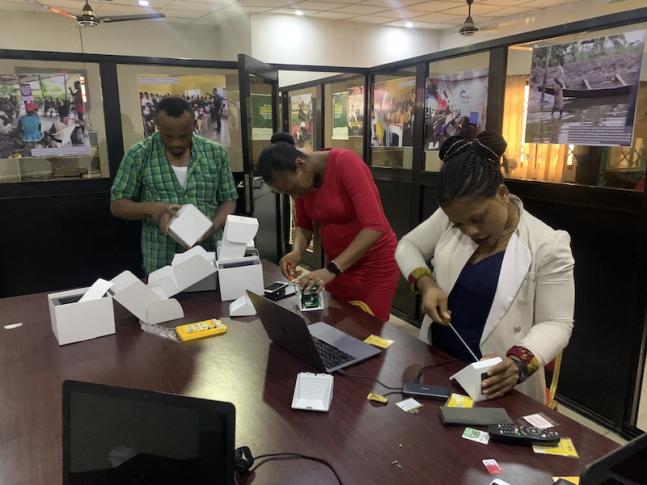
"If a tree falls in a forest and there’s no one around to hear it, does it make a sound?" This philosophical question of the 18th century about perception, observation and existence can also be observed in the pressing real-world problems of many remote and Indigenous communities in 2025. Is the Tapajós river in the Brazilian Amazon really polluted by illegal gold mining if the local river dwellers cannot prove it? Are communities in the oil-producing Niger Delta region of Nigeria really suffering from gas flaring if there are no public statistics documenting it? Are changes in micro-climate in Western Java undermining food security if no local weather data is recorded? The answer is three times yes. But unlike the 18th century, nowadays sensors can be put at the service of those affected to empower local voices in their pursuit to detect and document socio-environmental violations – in such a way that governments and corporations cannot refuse to recognise the problem.
Until quite recently, environmental sensors have been expensive and hard to use, but the rise of low-cost devices with open-source software to control them, along with open data platforms to share and compare information, have created many possibilities to measure and interact with the world surrounding us. Commercial ready-made sensors are widely promoted for purposes from protecting homes from burglars to remotely cultivating ornamental plants in an apartment, yet these only represent a tiny share of relevant and replicable use cases. Beyond these gadgets there is a movement going on among people: a creative and needs-based appropriation of such technologies.
An ongoing exploration
Committed to ensuring that the needs and visions of communities should guide the design and implementation of technologies, the Local Network Initiative (LocNet) led by APC and Rhizomatica supports the participatory exploration and development of practical sensor solutions. In a first phase, LocNet engaged in a dialogue to learn more about the demand for digital local services in communities. Agriculture and environmental monitoring as well as territorial defence are some of the fields pointed out as promising for localised applications of sensors.
To encourage autonomous and sustainable use of sensors, LocNet also supports the development of open hardware. A concrete example is the OMPPT charge controller; its circuit board has already been customised for the integrated and remote use of sensors and relays in an automated irrigation solution. The OMPPT can also be a foundational building block to directly gather and process data from other smaller solar-powered sensor boards (e.g. ESP32) covering bigger areas of agricultural lands or territories to monitor.
Considering the nature of most communities benefiting from sensor technologies and the challenges many of them face in terms of power supply, solar-powered sensors are an ideal solution to ensuring that even the remotest of places with limited power infrastructure can make meaningful use of sensors.
Success stories and pilot experiences from Nigeria, Indonesia and Colombia
An example of a successful sensor use case is the work of the Media Awareness and Justice Initiative (MAJI) in Nigeria. MAJI is based in Port Harcourt, which is at the centre of some of the most polluting terrestrial oil extraction on the planet. To help local communities taking action against polluters with real evidence that can hold up in court, solar-powered community-based sensors monitor the air quality in areas affected by gas flaring, as a means of documenting the conditions that are harmful to health.
Another sensor project being developed is the use of local weather stations in Indonesia which combine a set of wind, rain, temperature and humidity sensors with community-centred connectivity solutions to monitor micro-climates in areas still not covered by state meteorological stations. This citizen-science approach will contribute to the creation and sharing of baseline data, which will be exchanged with national and international stakeholders working on the mitigation of climate change. Further, the participating rural communities will obtain a local digital infrastructure that can be extended for the hosting of other digital services related to agriculture, education, communications and disaster relief.
In Colombia, Colnodo has developed an Environmental Monitoring Kit to monitor air and water quality and sound pollution. The kit was piloted and sent to Red INC community networks and Jxa'h Wejxa Casil network. These communities tested the devices, their management and data transmission, evaluating the user experience within their territories. This participatory approach was able to identify a need for community support and capacity building in the use of the devices and planning for their use with more efficiency in the community's daily life. Processes like these place communities as the protagonists of their own community environmental monitoring, promoting the collection and analysis of environmental data for decision making.
Join the community of practitioners
While possibilities for using sensors are virtually endless, there also needs to be awareness of the varying expectations of the communities and their levels of preparedness for working with these devices. For some of them, this is just an interesting weekend tinkering project; for others, their successful implementation is tied to critical livelihood questions and vital social-environment rights. The installation and maintenance of sensors might be trivial for tech-savvy people, but for some communities, the introduction of promising but unfinished prototypes can become a frustrating burden instead of a practical support tool.
This is why a dedicated community of practice can make a unique contribution, matching technological potentials with concrete needs, consolidating enthusiastic plans with realistic scenarios, testing supposed solutions with real world challenges, and much more.
We invite you to sense with the sun by writing to us in order to join this growing community, to learn, share and participate. Looking forward to hearing from you here: sensor-cop@apc.org
Photo: MAJI